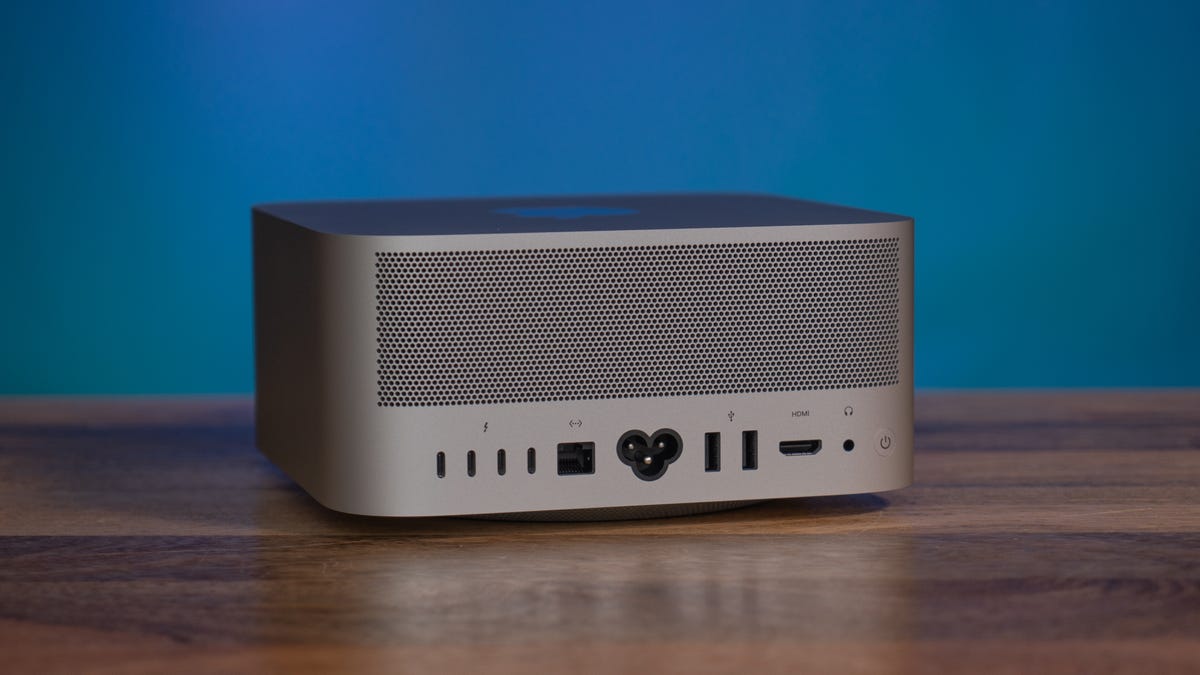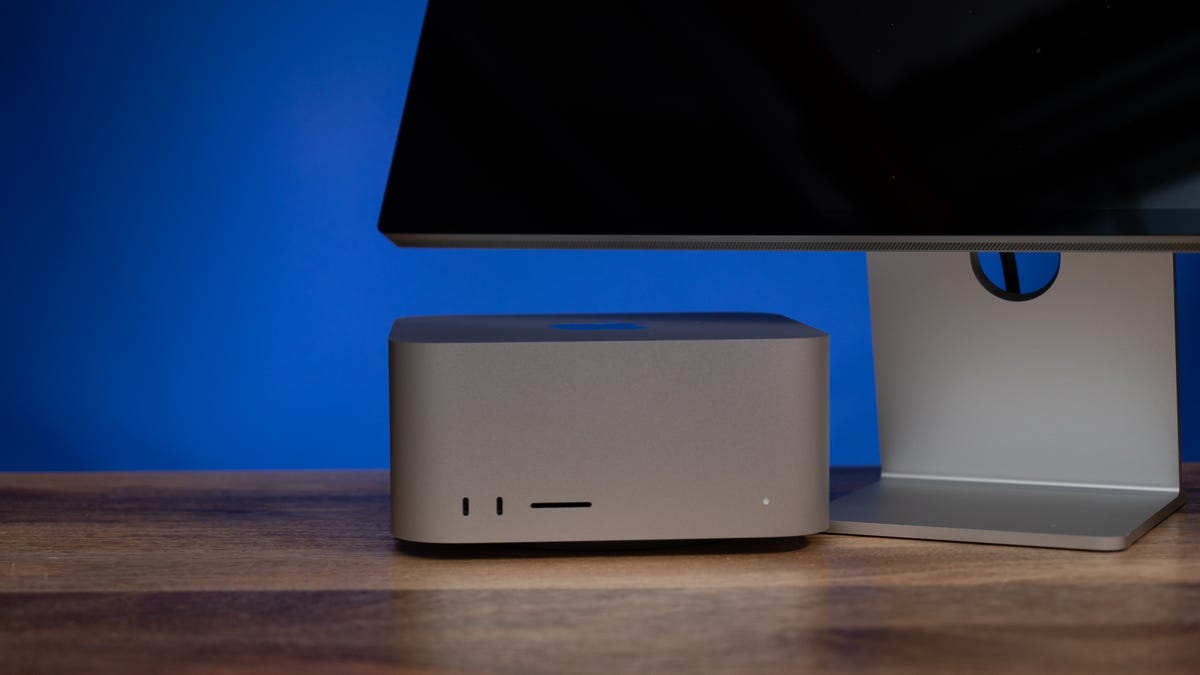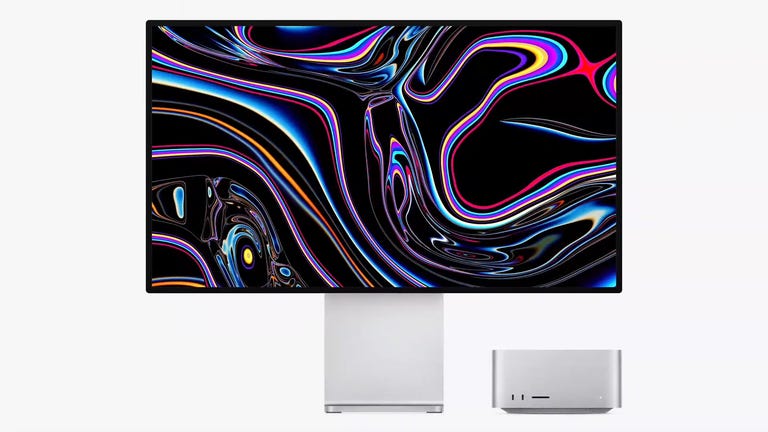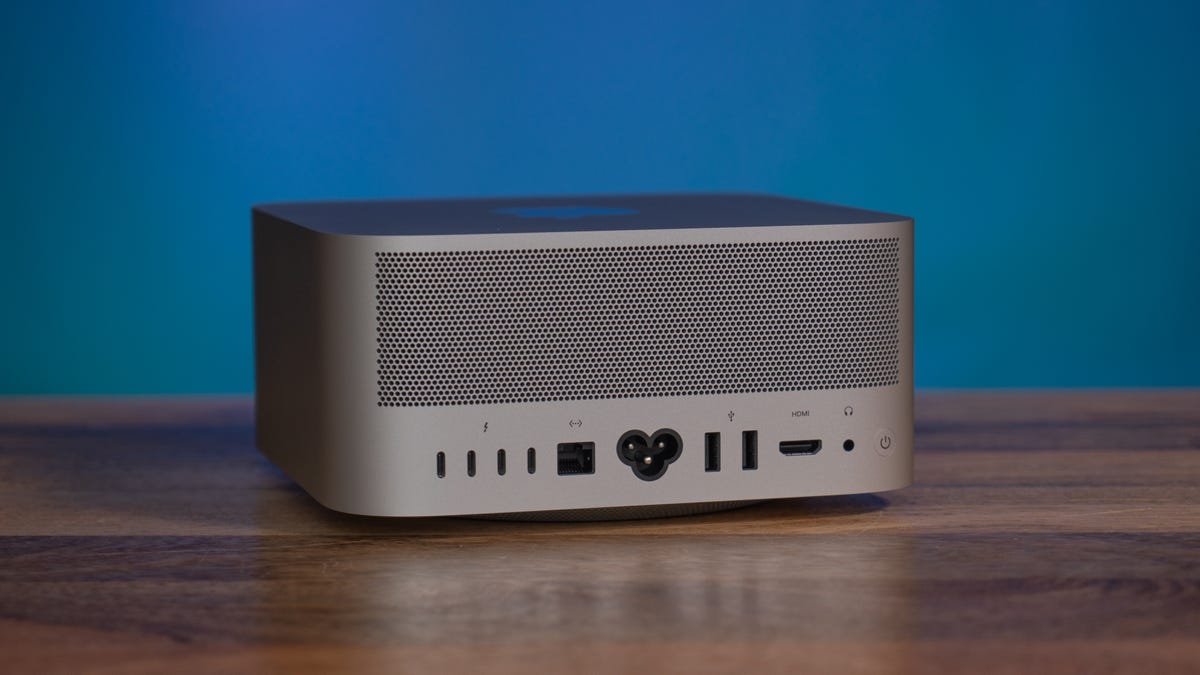Technologies
Apple Mac Studio 2023 Review: Still the Creative Choice for Mac
There aren’t many changes to Apple’s midrange desktop. There didn’t need to be.

Like
- Fast and quiet
- Relatively compact
- HDMI 2.1
Don’t like
- M2 Max model has two less Thunderbolt connections than the M2 Ultra
There isn’t a lot to say about the latest generation of the Mac Studio: From a «put it on your desk and use it» perspective, it feels almost exactly like the model that preceded it, with the expected generation-over-generation tweaks we see routinely in laptops and desktops.
In sum, it delivers up to about 20% better performance over the equivalent last-generation M1 chip because it has more CPU and GPU cores, and because of the updated Wi-Fi (from 6 to 6E) and Bluetooth 5.3, it has more stable and potentially much faster wireless. That, plus upgraded HDMI 2.1 — what Apple refers to as «enhanced» HDMI — are certainly important new features, they just don’t change the experience much.

As much as I like the system — and I really do like it quite a lot — it’s a little hard to make a case for the M2 Max model. If you really need CPU and/or GPU power, you’re better off with an Ultra configuration at a not-cheap $4,399 ($3,999 if you lop a terabyte off the storage of our $3,199 test configuration). If you just want the CPU performance and are OK with a decent-ish GPU, the M2 Pro Mac Mini can be had for $1,000 less.
Apple Mac Studio 2023
| Price as reviewed | $3,199, £3,299, AU$5,099 |
|---|---|
| CPU | 3.3GHz Apple M2 Max 12 cores (8P/4E), 16-core Neural |
| Memory | 64GB LPDDR5 unified |
| Graphics | Integrated 38 cores |
| Storage | 2TB Apple SSD, SD card slot |
| Ports | 6x USB-C (2x Thunderbolt 4), 2x USB-A, 1x HDMI 2.1, 3.5mm audio |
| Networking | 10Gbps Ethernet, Wi-Fi 6E (802.11ax), Bluetooth 5.3 |
| Operating system | MacOS Ventura 13.4 |
| Dimensions | 3.7 x 7.7 x 7.7 in (9.5 x 19.7 x 19.7 cm) |
| Ship date | June 2023 |
Many creative apps, notably photo editing, still tend to use CPU resources more than GPU, and the M2 Pro has the same Neural cores as the M2 Max. And, while the Max handles some basic high-res video editing, you can get away with the cheaper model for 4K, but will probably want to bump up for higher resolutions.
Much also depends on what creative applications you’re using as well as how you’re using them. You’ll see a lot more custom MacOS optimization from, say, DaVinci Resolve than Premiere Pro, so throwing money at the Max over the Pro may not help you. And features that might theoretically benefit from more Neural cores (the Ultra has 2x the Max and below), may not perform the processing locally. For instance, the processing for Photoshop’s new Generative Fill takes place remotely, so your system doesn’t really have to do any heavy lifting.
The Pro also has the same encode/decode accelerators as the Max, while the Ultra has twice as many. And the Ultra configuration has two more Thunderbolt ports — its dual Max processor configuration means another Thunderbolt controller — which is important if you plan on using external drives for that.

03:14
That doesn’t mean there isn’t a group of buyers for whom the M2 Max combination of solid CPU and GPU performance is just right for the money — it’s just easier and probably sufficient to go cheaper or necessary to go pricier.
The upgraded HDMI means it can handle a 4K monitor at a refresh rates of up to 240Hz. It does enable variable refresh rate for monitors that support it, and as with the MacBook Pro you don’t have much control over it; you enable it in MacOS and it’s out of your hands.
Aside from gaming, where it’s key for avoiding artifacts caused by the disconnect between game frame rate and display screen update, one of the main reasons for VRR (ProMotion) is to save power on devices like the iPad and iPhone. That’s not a huge issue for a desktop, so unless you’re gaming you’re better off just setting it to a high but fixed rate and leave it.

The port layout is the same as it’s been since the system launched.
If you do plan on gaming, I’d wait for MacOS 14 Sonoma before committing. Depending on how many game developers take advantage of Apple’s DX11/DX12 emulation so you can run Windows games, and depending on how they perform, you may want to adjust your GPU requirements. At the moment, there aren’t many native Apple silicon games; most are mobile games running on top of Apple’s Rosetta emulator. You can run a virtual Windows machine like Parallels, but I’d probably vote Ultra for that.
Performance
Apple silicon’s performance remains remarkably consistent, in the sense that it’s more or less directly correlated with the number of cores (though that doesn’t mean it’s true for any specific application, because they’re too squidgy when it comes to producing generalizable results).
The 38-core GPU in the Studio’s M2 Max delivers about 20% better Metal performance over the 32-core GPU in the M1 Max, almost entirely because of the increase in the number of cores. For a frame of reference, the 38-core performance puts it roughly comparable to an Nvidia GeForce RTX 4060 Ti, at least in one cross-platform benchmark (3D Mark Wild Life Extreme Unlimited), but there are a variety of metrics that simply aren’t reflected by that test.
Read more: Apple MacBook Air 15-Inch Review: Finally, Big for Less
Using it, though, we can extrapolate that the M2 Ultra’s 76-core version should provide a little less than twice that of the 38-core M2 Max and fall a little short of the RTX 4070 Ti. One interesting pattern that I see is that the more GPU cores there are the less you get out of each individual core within a given generation and about a 5% increase per core from M1 to M2.
As we’ve seen with the M1 generation, multicore CPU performance is almost identical for a given core configuration — in other words, the 12-core M2 Pro’s as fast as the 12-core M2 Max — and about 20% faster than the 10-core M1 Max. Because more cores. Single core speed is up by about 14%. For reference, the CPU performance seems about the same as an Intel Core i7-13700H.
I’ve only had a few days with the system, so I’m still sorting out the various performance nuances. I’m comfortable with the conclusions I’ve drawn thus far — it remains the excellent system it was when it debuted last year — but if necessary may update with more about this particular configuration for creative work and gaming.
Cinebench R23 CPU (multicore)
Cinebench R23 CPU (single core)
3DMark Wild Life Extreme Unlimited
Configurations
| Apple Mac Mini (M2 Pro, 2023) | MacOS Ventura 13.2; Apple M2 Pro (12-core CPU,19-core GPU); 16GB LPDDR5 RAM; 1TB SSD |
|---|---|
| Apple Mac Mini (M2, 2023) | MacOS Ventura 13.2; Apple M2 (8 CPU cores, 10 GPU cores); 8GB LPDDR5 RAM; 256GB SSD |
| Apple Mac Studio (M1 Max, 2022) | MacOS Monterey 12.3; Apple M1 Max (10 CPU cores, 32 GPU cores); 64GB RAM; 2TB SSD |
| Apple Mac Studio (M2 Max, 2023) | MacOS Ventura 13.4; Apple M2 Max (12 CPU cores, 38 GPU cores); 64GB RAM; 2TB SSD |
| Apple MacBook Pro (14-inch, 2021) | MacOS Monterey 12.4; Apple M1 Pro (10 CPU cores, 16 GPU cores); 32GB LPDDR5 RAM; 1TB SSD |
| Apple MacBook Pro (16-inch, 2021) | MacOS Monterey 12.4; Apple M1 Max (12 CPU cores, 32 GPU cores); 32GB RAM; 512GB SSD |
| Apple MacBook Pro (16-inch, 2023) | MacOS Ventura 13.2; Apple M2 Pro (12 CPU cores, 19 GPU cores); 32GB LPDDR5 RAM; 1TB SSD |
Technologies
The Most Exciting Video Game Rumors and Leaks Ahead of 2026
Technologies
Today’s NYT Mini Crossword Answers for Wednesday, Dec. 17
Here are the answers for The New York Times Mini Crossword for Dec. 17.

Looking for the most recent Mini Crossword answer? Click here for today’s Mini Crossword hints, as well as our daily answers and hints for The New York Times Wordle, Strands, Connections and Connections: Sports Edition puzzles.
Need some help with today’s Mini Crossword? Read on. And if you could use some hints and guidance for daily solving, check out our Mini Crossword tips.
If you’re looking for today’s Wordle, Connections, Connections: Sports Edition and Strands answers, you can visit CNET’s NYT puzzle hints page.
Read more: Tips and Tricks for Solving The New York Times Mini Crossword
Let’s get to those Mini Crossword clues and answers.
Mini across clues and answers
1A clue: Nod (off)
Answer: DOZE
5A clue: Naval submarine in W.W. II
Answer: UBOAT
7A clue: Tricky thing to do on a busy highway
Answer: MERGE
8A clue: Heat-resistant glassware for cooking
Answer: PYREX
9A clue: Put into groups
Answer: SORT
Mini down clues and answers
1D clue: Break up with
Answer: DUMP
2D clue: Falls in line, so to speak
Answer: OBEYS
3D clue: Legendary vigilante who cuts a «Z» with his sword
Answer: ZORRO
4D clue: Rarin’ to go
Answer: EAGER
6D clue: Common reminder for an upcoming appointment
Answer: TEXT
Don’t miss any of our unbiased tech content and lab-based reviews. Add CNET as a preferred Google source.
Technologies
You Can Watch an Exclusive Avatar: Fire and Ash Scene on TikTok Right Now
Disney and TikTok partner on an immersive content hub for James Cameron’s latest movie about the alien Na’vi.
If you’re not quite ready to head to the theater to watch Avatar: Fire and Ash, an exclusive scene preview might sell you on the visual spectacle. As part of a new collaboration with the social media giant, Disney is posting snippets of its new movie to its TikTok account.
This scene isn’t part of any trailer and won’t be posted to other social media accounts, making TikTok the only place you can view it — unless you buy a movie ticket. A first look at the new movie’s scenes isn’t the only Avatar-related bonus on the social media platform right now, either. TikTok has partnered with the house of mouse to bring an entire «immersive content hub» to the app.
A special section of TikTok includes quizzes and educational videos that explore the alien world of Pandora shown off in the movies. On TikTok, you can take a personality quiz to find out what Na’vi clan you most closely align with and unlock a special profile picture border to use on your account.
Science and fiction blend together with a series of videos from real doctors who explain the basis for some of Avatar’s world-building. If you want to learn about exoplanets or how realistic the anatomy of the movie’s alien animals is, these videos will feed your brain while still providing entertainment value.
Perhaps the most enticing part of Disney’s latest social media collaboration is the opportunity for fans to win prizes and trips. TikTok creators who make edits with the #TikTokAvatarContest hashtag are entered into a competition to win Avatar merchandise. The biggest winners will be able to take a trip to visual effects studio Wētā Workshop in New Zealand or visit Avatar director James Cameron’s Lightstorm Entertainment Studio in Los Angeles.
Avatar: Fire and Ash is the third installment in director Cameron’s cinematic passion project. While the first Avatar movie was released in 2009, Cameron didn’t release another entry in the franchise until 2022. In total, there is a five-movie arc planned for the indigo alien Na’vi on the moon of Pandora.
The Avatar movies are known for pushing the boundaries of CGI visual effects in cinema. They are also historically big winners at the box office: the original Avatar is the highest-grossing film of all time, earning $2.9 billion across its theatrical releases. Its sequel, Avatar: The Way of Water, is the third-highest-grossing film of all time, trailing Avengers: Endgame. You can stream those movies on Disney Plus.
It remains to be seen whether Avatar: Fire and Ash will financially live up to its predecessors. The film currently has mixed reviews from critics on Rotten Tomatoes.
-

 Technologies3 года ago
Technologies3 года agoTech Companies Need to Be Held Accountable for Security, Experts Say
-

 Technologies3 года ago
Technologies3 года agoBest Handheld Game Console in 2023
-

 Technologies3 года ago
Technologies3 года agoTighten Up Your VR Game With the Best Head Straps for Quest 2
-

 Technologies4 года ago
Technologies4 года agoBlack Friday 2021: The best deals on TVs, headphones, kitchenware, and more
-

 Technologies4 года ago
Technologies4 года agoVerum, Wickr and Threema: next generation secured messengers
-

 Technologies4 года ago
Technologies4 года agoGoogle to require vaccinations as Silicon Valley rethinks return-to-office policies
-

 Technologies4 года ago
Technologies4 года agoOlivia Harlan Dekker for Verum Messenger
-

 Technologies4 года ago
Technologies4 года agoiPhone 13 event: How to watch Apple’s big announcement tomorrow

